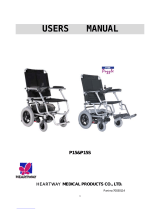
WARNING!
•
If you are under the influence of medicines that can have an
effect on your ability to drive, you are not permitted to drive
a wheelchair.
• Adequate vision is required in order to safely operate a
wheelchair in the user situation concerned.
•
•
Not more than one person at a time
can be seated in the
wheelchair.
Do not allow children to ride in the wheelchair
unsupervised.
CAUTION!
•
The user of the wheelchair is at all times completely
responsible for complying with the applicable local safety
regulations and guidelines.
Attendants
When an attendant control module is fitted, the Power
Wheelchair may be operated by an assistant on behalf of
the user.
When a Dual Control Module is fitted the Power
Wheelchair may be operated by the user, or control may be
switched to an assistant to operate on behalf of the user.
•
Make sure you heed all warnings and follow all instructions
in each section of this manual. Warnings that apply to the
user also apply to you.
• Do not stand or sit on any portion of this seating system.
• You need to work with the user, and the user’s doctor, nurse
or therapist, to develop safe methods best suited to your
abilities and those of the use .
• Check to make sure push handle grips will not rotate or slip
off.
•
Make sure you always have comfortable access to the
attendant controls while the chair is moving and make sure
that the controller is fitted securely to the chair.
• Set the speed of the attendant control to a speed that you
can comfortably follow.
• Always turn off the power to the controller when leaving the
user in the chair.
Fig. 3.2
3.2 Area of application: The user e
nvironment, Fig. 3.2
This wheelchair has been designed to accommodate both
indoor and outdoor use (ANSI/RESNA WC-1:2009). When
driving the wheelchair outdoors, drive only on paved roads,
pavements, footpaths and bicycle paths. The speed must be
adapted to suit the environment.
WARNING!
•
•
Drive carefully on slippery roads resulting fr
om rain, ice or
snow!
You are required to turn on the lights in case of limited
visibility.
•
When driving at higher speeds you must be extra careful.
Select a lower maximum speed indoors, on the pavement
and in pedestrian areas.
• Do not drive off high obstacles.
• Do not attach a weight to the wheelchair without the
approval of a qualified specialist. This may negatively affect
the stability of the product.
CAUTION!
•
Prevent the wheelchair from coming into contact with sea
water: sea water is caustic and may damage the wheelchair.
• Prevent the wheelchair from coming into contact with sand:
sand can permeate into the moving parts of the wheelchair,
causing extensive wear on these parts.
• Do not use the wheelchair if temperatures are below: 15˚F
(-10˚C) or above 120˚F (+50˚C).
• Do not open doors using the leg rests.
• Do not push and/or tow any objects with the wheelchair.
• Do not drive through puddles of water.
• Make sure the battery cover is secure.
• Never take your chair into a shower, tub, pool, or sauna.
• Dry the chair as soon as you can if it gets wet, or if you use
water to clean it.
WARNING!
DO NOT use any wheelchair that has been involved in a
motor vehicle accident. A sudden stop and/or collision
may structurally damage your wheelchair. There may
have been a change to the structure of the chair, and/or
damaged or broken some of the components.
Wheelchairs involved in sudden stops should be
inspected for possible failures in frame and/or
components. Frame damage may be represented by but
not limited to: visual cracks, dents, metal distortion,
bends, or damage to the seating mounting. If the chair
no longer drives straight, it could be damaged. If the
wheelchair has been involved in an accident, discontinue
use immediately and contact your authorized dealer for
a thorough inspection. If damage is questionable or if
there is concern regarding the condition of the chair,
Sunrise Medical recommends repair/or replacement of
the chair depending on the extent of the damage.
NOTE- The warranty is void on any wheelchair that is
involved in a collision.
251688 Rev. A






















